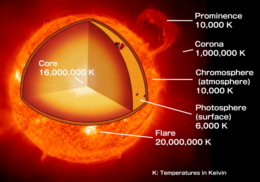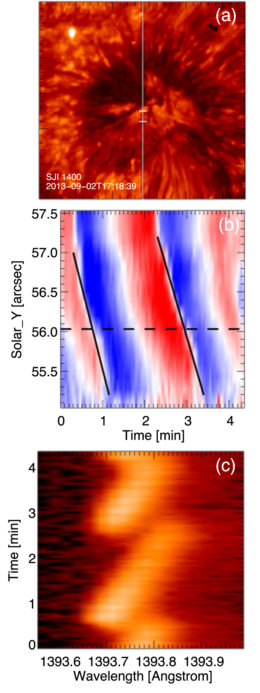Despite the Sun’s proximity, there’s still a lot we don’t know about our nearest star! A new study, however, has brought us a step closer to understanding one of its mysteries: how the solar atmosphere is heated.

The temperatures of different layers of the Sun. The Sun’s atmosphere gets progressively warmer with increasing distance from the core, from the photosphere at 6,000 K, to the chromosphere at 10,000 K, to the corona at 1,000,000 K. [ISAS/JAXA]
Blame Shocks for Heating?
The outer layers of the Sun present an interesting conundrum: instead of continuing to drop in temperature with increasing distance from the Sun’s hydrogen-fusing core — the way the Sun’s inner layers do — the atmosphere above the Sun’s surface becomes progressively hotter with distance. How is heat getting delivered from the Sun’s center to these outer layers?
One possible culprit is shocks. Oscillations continuously travel through the Sun’s interior to its surface, launching compressible waves into its atmosphere. These waves can then evolve into shocks as they propagate outward — and the dissipation of these shocks can deposit energy into the Sun’s atmosphere, contributing to its heating.
Besides their potential role in atmospheric heating, these shocks serve a number of other purposes that should encourage us to study them. They are thought to serve as the trigger for observed phenomena, such as the tiny chromospheric jets driven in active regions. Furthermore, they can be used to probe the solar atmosphere — measuring shock properties can tell us more about the structure of the environment through which they propagate.
Theory and Observation Combined

Observational data used by the authors to derive the properties of two successive shock waves observed by IRIS. a) IRIS image, spanning 47” x 47”. The vertical line indicates the location of the spectrograph slit. b) the Doppler velocity of Si IV 1393.76 Å in the region marked by the horizontal white lines in panel (a). c) A wavelength-time plot of Si IV 1393.76 Å. [Adapted from Ruan et al. 2018]
To address this challenge, a team of scientists at Peking University, the Chinese Academy of Sciences, and KU Leuven in Belgium have now developed a means of quantitatively analyzing the shocks we observe in the Sun’s atmosphere. In a recently published study led by Wenzhi Ruan, the team presents analysis that determine shock properties by using the theoretical physics of shocks in combination with quantities derived from simultaneous imaging and spectroscopic observations.
Testing the Approach
To test their analysis, the team takes two approaches. First, they apply the analysis to real shock observations — imaging and spectroscopy of two successive shock waves captured by the Interface Region Imaging Spectrograph (IRIS) observatory — and demonstrate that the shock properties they find are physically reasonable and consistent with each other.
Next, the authors model shocks using numerical simulations, and they generate synthetic observations of how these shocks would appear to an observatory like IRIS from different viewing angles. They then apply their analysis to the synthetic observations and demonstrate that they can recover the original properties of the shocks in all cases, indicating that their method is reliable and independent of viewing direction.
The authors encourage other researchers to use their analysis code (you can find it here) as a standard approach for quantitatively exploring shocks in the solar atmosphere. This work is a crucial step toward better understanding how these shocks deposit heat, and how they interact with and influence the atmosphere of the Sun.
Citation
Wenzhi Ruan et al 2018 ApJ 860 99. doi:10.3847/1538-4357/aac0f8

